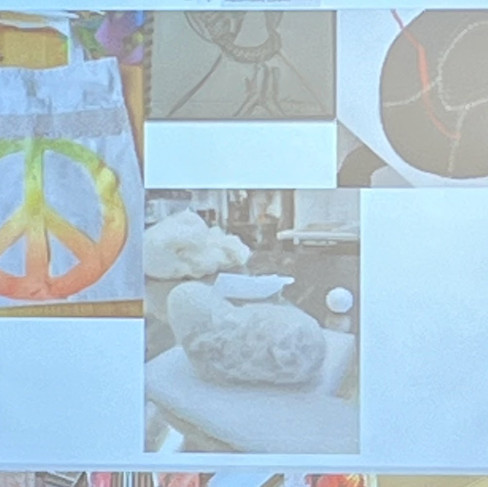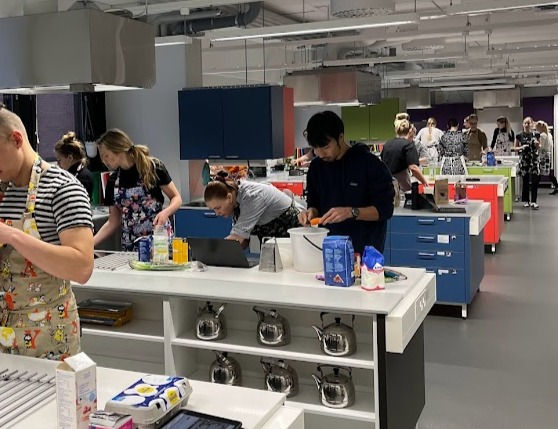Crafts and Wellbeing - University Course Observations and Inspirations for the Career and Technical Education Classroom
- Dawn Oler

- Apr 9, 2024
- 8 min read

Craftivism is a way to educate and engage our community. It supports well-being and promotes idea sharing.
Please remember that I am going to put some observations here through the lens of a U.S. teacher. I will try to formulate my thoughts in a way that is inquisitive and appreciative of the societal differences and expectations. Throughout this post you will see images that were taken during the presentations and of the products created. These have been shared with permission.
I was invited to observe presentations of the Craft and Wellbeing course at the University of Eastern Finland. The course goals: "The elements, meanings and development trends that enhance the wellbeing via crafts. Crafts in promoting mental wellbeing and empowerment. Crafts and shared expertise in a collaborative wellbeing project." The students were tasked with creating a project using crafts as a contributor to wellbeing. All projects were interactive and students gathered feedback and reflected on their experiences. A very special thank you to Professor Sirpa Kokko and her students.

The interactive station seen here was set up in the commons. It included a description of the project,
all materials needed, directions on how to sew the squares on and a feedback tool.
The first project I observed was fascinating. These young people were inspired by an exhibit at the Telus Spark Science Center in Canada. One of the exhibits there is a wall where people can write their secrets on paper and insert them into tubes in the wall. Students in this group were inspired by this. These students set up a display in the common area on campus with directions for students to write secrets on the back of fabric and then sew it to the fabric canvas.
The feedback from those who participated indicated it was quick to do and it gave them a chance to move away from their thoughts about studying amongst other things. There was some suspicion about the project and those who participated wanted to know where it would go after completed. The responses did indicate that it was a positive experience. As I was listening to this I immediately thought some iteration of it would be great to do in schools. So below each synopsis here you will see a bolded lesson plan integration idea. Please leave a comment or contact me if you have other ideas or do use any of these in some way.

The textile shown has secrets written on the back of each square and then sewn by the writer onto the fabric.
Lesson Plan Idea: In your school common area or within a classroom with directions and materials to create a piece. Medium could be any number of materials and students could write or draw. Possible mediums: windows and dry erase markers (temporary), fabric, canvas, display case, etc.
A hope or dream for the future.
Advice to other students
What inspires them
Their favorite quote
Questions they have and then others could answer
The images shown reflect the students use of craftivism to communicate their views on rigths issues.
The second project was on Craft Activism students where thinking about an issue they want to take a stand on and ended on United Nations Declaration of Human Rights statement as their main theme. The students work is a reflection of not only what is shown in the media but their personal feelings. Pieces were created about children's rights, LGBTQIA? rights, animal rights, climate rights as well as the right to have stability in your life. All the pieces are meant to inspire people to take a part in an action to ensure these rights, which are not recognized in many countries. All themes were personal to the students so they felt as though they put more effort into the pieces and benefited more from the project as a result. This reflected their own wellbeing over the course of creating the pieces and contributing to the groups conversation about what was important for them to add their voice to. This group set up a display of their pieces for a week and a half and had an anonymous padlet via QR code for viewers to share their thoughts about the items and display.
Lesson Plan Idea: In any class discuss craftivism and issues students think are important to understand as adults within the concepts the course covers. Allow students to form small groups and chose their issue to create art around. Display in school and provide a forum for feedback.

The his was the marketing the third group used to attract students to their event.
The third project called "Crafting Together" was focused of the theme of Mental Health. Students arranged to play a game of bingo, with prizes, and invited students to bring unfinished craft projects to work on. Calming music played in the background and students where available to help those who attended problem solve and finish the projects they brought with. I could've used this session as I have some embroidery from 2020 that I haven't finished! Turnout for this event was low but feedback was positive from those who did attend. The students who created this event were reflective on the fact that the timing might not have been great for students.
Lesson Plan Idea: FCCLA or other CTSOs could host this opportunity before testing weeks, or high stress times in the schools. One way to alter this is that students who have a strength in one craft area could set up groups and teach others a quick skill.
The next group focused on child labor in the industrial textile industry. These students chose a really heavy topic for their fourth graders. The students had been working in this classroom prior to this series of lessons and the plan was developed in cooperation with the teacher. The fourth graders were taught about farming, factory, mining and other types of child labor (trafficking, drugs, etc.) followed by a discussion about these topics. Farming represents the highest percentage of child labor in the world.
The following lessons gave the fourth graders the opportunity to imagine the future and they were given materials to create the school of the future or a factory they planned in a 3D design (dioramas). Students had to include a word in their design that indicated why education is important.
Lesson Plan Idea: There are many courses that this activity could provide greater depth to. The opportunities to have students engage in the issues facing an industry are vast.
In Culinary Arts students could research concerns in the restaurant industry then create a project focusing on possible solutions.
In textiles/sewing/fashion students could look at the issues in the fashion industry and some of the ways the industry is trying to solve those challenges. Students could provide an analysis of various solutions.
In interior design/housing students could look at problems pertaining to housing design and construction and do a redesign (see my prior blog on PhBL)
In personal finance students could create a comparison of economic models, pros and cons to be shared.

The next group taught crocheting to immigrants located within the Joensuu community. These students connected with the JoMoni (Joensuu District Multicultural Organization) to offer this series of workshops. The students recognized that crafting was a tool to encourage communication and socialization among all people. The students taught the attendees to create granny squares. The students leading the workshops noticed that the participants had their own way of holding the yarn, wrapped around their fingers. In addition these events took place during Ramadan and the leaders were able to learn about a culture different from their own and felt comfortable asking questions and appreciated the welcoming feeling from the participants. This group is going to connect the all the granny squares created to make one big art piece.
Lesson Plan Idea: Similar to some of the ideas above, students could create opportunities within their school or community to welcome a diverse group of people to learn a skill together. This could be integrated into a service project, part of a CTSO or as a high level individual culminating activity with an authentic audience.
The last presentation was on the use of the Sense Lab (a multisensory behavior observation space) that I visited last month. These students looked at Cognitive Load Theory and the Theory of Well-Being. They conducted two simulations, one with face to face instruction and one with video based instruction. Students were taught a bead weaving technique. In the end, the group that watched a video for instruction was a little bit further in the process at the end of the time. But overall both groups ended with a very similar amount of finished product. Happiness level was comparable as well, so there was no documented difference in outcome. The research students noted one participant reflection "If you can't control the video for yourself you lose some of the elements of well-being." The student researchers also noted the limitations of this new space and would like the opportunity to gauge body responses in a scientific way.
Lesson Plan Idea: It would be absolutely fascinating for students to design a product in any of the Career and Technical Education courses and be able to run research like this. Imagine if students in Tech Ed design a product to solve a problem. Then the actual product(s) are tested and the designers can watch how the product is used. I think this would've been great in my culinary course. I needed to be able to hang mixer attachments under a metal counter. I found some 3D printer files for some and then the Tech Ed department printed them for me. I wonder if the students had come and watched how my students use the space and came up with their own designs how they would've turned out.
I really enjoyed observing this class and immediately I was filled with inspiration for my own courses. I would love to read these students reflections and reports on their projects. I can already tell they learned a tremendous amount, made an impact in their communities and will use that knowledge moving forward in their career goals.
Attending this class made me think about my own introduction to #Craftivism which was through Shannon Downey. She introduces herself like this "The short story is that I am an artist, activist, craftivist, community builder, and general instigator. I blend my politics,

activism, and art into projects that are designed to inspire others to take action, think, discuss, engage with democracy and their community, and find some digital/analog balance." It was the spring of Covid and Shannon was traveling in her RV across the country. I happened to be on her path and offered my driveway for her to park. She offered to teach my friends to cross stitch. There we sat during the summer of Covid on the driveway learning about her story and stitching away.
Today Shannon is celebrating her first book (learn more at the link) and given the topic of this post is based on craftivism I thought it was appropriate to give her some recognition. Somehow today in my life two very different worlds intersected in very cool ways I never imagined.
Sources:
Craft and Wellbeing Course Page: https://opas.peppi.uef.fi/en/course/FS00CM99/109309?period=2023-2024
Joensuu district multicultural association: JoMoni: https://www.jomoni.fi/home-en.html
UEF Sense Lab: https://uefconnect.uef.fi/tutkimusryhma/senselab/
Shannon Downey Website: https://www.badasscrossstitch.com/
The author of this website/blog/etc. is a participant of the Fulbright Distinguished Awards in Teaching Research Program (Fulbright DA), a program sponsored by the U.S. Department of State’s Bureau of Educational and Cultural Affairs (ECA) with funding provided by the U.S. Government and administered by IREX. The views and information presented are the participant's own and do not represent the U.S.































Comments